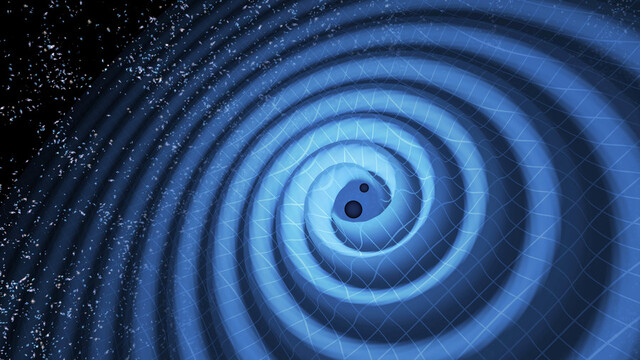From small to large: a study of gravitational waves using scattering amplitudes of subatomic particles
Queen Mary Professor Gabriele Travaglini was recently awarded a Leverhulme Research Fellowship and has written the following article for the Leverhulme Trust Newsletter.

Spiral dance of black holes. Gravitational waves ripple outwards as two black holes spiral toward each other. LIGO / T. Pyle.
Gabriele Travaglini’s project will use powerful scattering-amplitude methods to push the precision frontier in gravitational-wave research and develop novel, highly efficient ways to provide much-needed high-precision models to compare with new experimental data.
If you visit the Musée d’Orsay in Paris, you will have the chance to admire Starry Night Over the Rhône, a beautiful painting of the night sky by Van Gogh. To many, watching the sky at night conveys a sense of stillness and profound calm. But this is far from reality – deep into the sky, cataclysmic events continually occur: black holes and neutron stars collide, spiral around each other and merge while emitting immense amounts of energy in the form of gravitational waves.
In 2015, a century after Einstein’s prediction, gravitational waves were finally directly detected – by the LIGO and Virgo collaborations – opening a fascinating window into our universe that revealed events with extreme energies never probed before. While the first observations were based on very few merger events, future terrestrial and space-based gravitational-wave detectors will be able to capture evidence of millions of mergers per year, with unprecedented sensitivity well beyond that presently available at the LIGO and Virgo observatories. The future of gravitational-wave research relies crucially on achieving ever-more precise theoretical predictions to compare with these data, and my project aims to help with this endeavour.
Since the size of black holes and neutron stars is tiny compared to the wavelengths of gravitational radiation and the typical size of astronomical orbits, we can think of them as effectively point-like – a remarkable statement that can be made mathematically rigorous in the framework of ‘effective field theory’. This simple yet profound observation opens the extraordinary possibility of leveraging the range of methods developed over several decades to study the scattering of subatomic particles at colliders, such as CERN’s LHC, pushing the precision frontier in particle physics and gravitational physics alike. Scattering amplitudes – the quantum transitions between well-defined incoming and outgoing states – thus describe not just the dynamics of tiny particles but also the interactions of extraordinarily large astronomical objects. Furthermore, they have an intrinsic, fascinating simplicity that has revealed unexpected connections to many branches in mathematics, from twistor theory to number theory and string theory. A surprising ‘colour/kinematics’ duality has been discovered that relates gravitational amplitudes to non-gravitational ones via the so-called ‘double copy’. My project addresses the pressing demands for new theoretical predictions by combining powerful methods in scattering amplitudes, quantum field theory, effective field theory and the double copy to develop much-needed high-precision models.
Related items

27 June 2025

